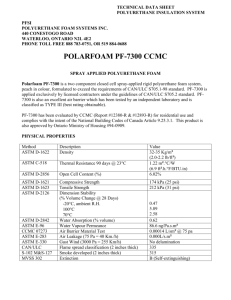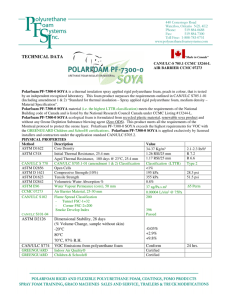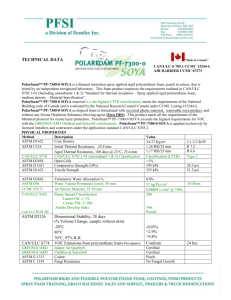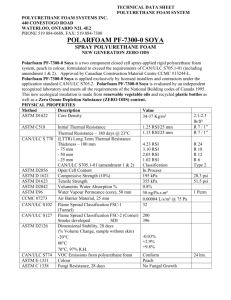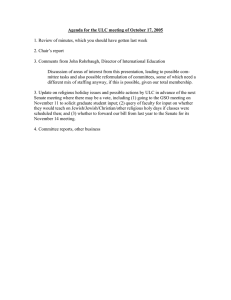Sprayed Polyurethane Foam in Construction
advertisement
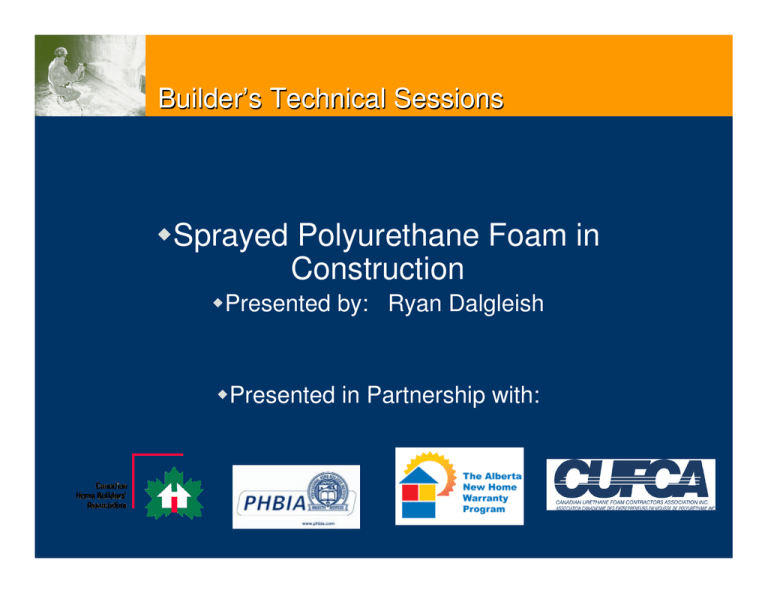
Builder’s Technical Sessions Sprayed Polyurethane Foam in Construction Presented by: Ryan Dalgleish Presented in Partnership with: THE SPRAY POLYURETHANE FOAM INDUSTRY’S ONLY INDEPENDENT THIRD PARTY QUALITY ASSURANCE PROGRAM Sprayed Polyurethane Foam Types of Foams Comparison between open-cell and closed cell SPF physical properties Standards for the foam industry – both medium density and open cell insulation Building code commentary – thermal Barriers, vapour barriers, cathedral Ceilings About CUFCA and the quality assurance program Resources for builders Types of Sprayed Polyurethane Foam Sealant Foams Light Density Open-Cell Sprayed Polyurethane Foam “foam in the can, froth paks” “half pound” Medium Density Closed Cell Sprayed Polyurethane Foam “two pound” High Density Closed Cell Sprayed Polyurethane Foam “three pound or more” Light Density - Open-Cell SPF Insulating material with an R-value of around 3.8 per inch. Soft to the touch Open cells that traps air / not a vapour barrier Interior application between framing members Expands 100 times from liquid state Material Standard has been developed (CAN/ULC S712.1) – Installation standard is under development CCMC evaluation is only method of code compliance Medium Density - Closed Cell SPF Insulating material with an R-value of 5.1 – 6 per inch. Rigid Material Closed cell with insulating gas Interior / exterior applications Expands 30 times from liquid state Currently has two standards (product: CAN/ULC S705.1 & Installation: CAN/ULC S705.2) – since 1988 (previously CGSB standards) Standards are referenced in NBC and Provincial Codes (Part 5 and Part 9) CCMC listing of products – insulation/air barrier Comparison Property Medium Density – Closed Cell Light Density – Open Cell R-value 5.1 – 6.0 3.6 – 3.8 Chemical Components A – Iso / B – Resin A – Iso / B - Resin Air Barrier Yes, at minimal thickness Yes, > 5.5 inches or more * Vapour Barrier Yes, at 2 inches NO Thermal Barrier Required (interior living space) Required (interior living space) Health & Safety Applicator/Spray Area Applicator/Spray Area Installation 30 times expansion 2 inch pass max 100 times expansion Full cavity Sound Blocks air leakage Blocks air leakage and absorbs VOC’s CAN/ULC S774/time to occupancy CAN/ULC S774/time to occupancy Application Interior/exterior/below grade/open surfaces Interior only between framing members Ozone Depletion Zero ODP Zero ODP Building Code 2005 National Building Code and Provincial Codes cover “Medium Density-Closed Cell” American produced material NOT covered Light Density – Open Cell material not currently referenced – standard will be referenced in future codes Other materials NOT covered (high density roofing foams) Canadian Construction Materials Center Currently, all manufacturers that produce a medium density – closed cell material that meets the CAN/ULC S705.1 have received a CCMC listing. For Light Density – Open Cell, a CCMC evaluation report is available and should be requested To view any CCMC reports, go to http://irc.nrc-nrc.gc.ca/ccmc/ Sprayed Polyurethane Foam CAN/ULC S705.1-01 Material Standard – Medium density closed cell CAN/ULC S712,1-09 – Material Standard Light density open-cell CAN/ULC S705.01 Material Standard Medium Density, Closed Cell Requirements Property Unit Min. Max. Test Method Air Permeance (Mandatory material only testing) L/s @ 75 Pa - .02 CCMC Technical Guide for Air Barrier Materials Air Permeance (Optional system testing) L/s @ 75 Pa - .05 Apparent Core Density kg/m³ 28 - CCMC Technical Guide for Air Barrier Systems ASTM D 1622 Compressive Strength kPa 170 - ASTM D 1621 % % % -1 - - 1 +8 + 14 - - 500 % - 8 Initial Thermal Resistance for a 50 mm specimen after 3 d at 23 ± 2°C m²·°C/W Declared Long Term Thermal Resistance (For a 50 mm thick specimen) Type 1 Type 2 Tensile Strength m²·°C/W Dimensional Stability Volume Change at : -20°C 80°C 70°C, 97 ± 3% RH Surface Burning Characteristics Flame Spread Open Cell Content, Volume ASTM D 2126 CAN/ULC S102 ASTM D 2856 ASTM C 177 or C518 CAN/ULC-S770 kPa 1.8 2.0 200 - ASTM D 1623 Volatile Organic Emissions - Pass - CAN/ULC S774 Water Absorption by Volume % - 4 ASTM D 2842 ng/(Pa·s·m²) - 60 Water Vapour Permeance for a 50 mm thick specimen ASTM E 96 CAN/ULC S712.01 Material Standard Low Density, Open Cell Requirements Property Air permeance at 100 mm Apparent core density Dimensional stability volume change at : -20°C 80°C 70°C, 97 ± 3% RH Fungi resistance Unit Min. Max. L/(s·m²) @ 75 Pa pressure difference - Declare kg/m³ 6.8 12 % - Shrinkage -1 -15 -15 ASTM D2126 - ASTM C1338 ASTM D6226 80 - Surface burning characteristics Flame spread Thermal resistance for a 50 mm specimen - - 500 m²·K/W 1.20 - days 1 30 % % - Declare 50 ng/(Pa·s·m²) 1400 or 400 depending on water absorption - Water vapour permeance for a 50 mm thick specimen ASTM D1622 No growth % Water absorption by volume -For materials with WVP ≥1400 -For materials with WVP less than 1400 and greater then 400 ASTM 2178 Growth +10 +10 +14 Open-cell content, volume Time to occupancy Test Method CAN/ULC S102 ASTM C177 or ASTM C518 CAN/ULC S774 ASTM D2842 ASTM E-96 Material Standards Low Density, Open Cell vs. Medium Density, Closed Cell Differences Between Standards Most test methods are the same for both products Some test methods conducted on each product that are unique to that product ie. LTTR, Compressive strength for medium density Ie. Fungi resistance for open cell Foam Colours Medium Density – Closed Cell: Manufacturer A – Green, Peach Manufacturer B – Blue, Purple Manufacturer C – Orange Typically md-cc foam’s natural colour is Yellow. This would indicate a product that DOES NOT meet code. Light Density – Open Cell: No requirement for colour at this time Medium Density – Closed Cell Standard CAN/ULC S705.2-05 Installation Standard Medium Density – Closed Cell CAN/ULC S705.2-05 Installation Standard Requirements for: Installer must carry photo-identification card Installer must meet all installation requirements for environmental conditions, substrate preparation, application requirements and limitations Installer must have spill containment materials On-site testing (density/adhesion/cohesion) Medium Density – Closed Cell CAN/ULC S705.2-05 Installation Standard Installer must properly store material and decontaminate & dispose of empty drums properly Installer must conduct daily density, adhesion and cohesion testing Installer must complete Daily Work Record Installer must attach Job Site Label Troubleshooting (on-site QC) THE SPRAY POLYURETHANE FOAM INDUSTRY’S ONLY INDEPENDENT THIRD PARTY QUALITY ASSURANCE PROGRAM Medium Density – Closed Cell Job Site Documentation Medium Density – Closed Cell Installer Identification Certified Installer Card Registered Apprentice Card Light Density – Open Cell CAN/ULC S712.2 Installation Standard Requirements very similar to CAN/ULC S705.2 In draft at ULC / SPF Task Group level Includes items such as on-site testing, substrate preparation, job site set-up, troubleshooting/repair, safety, documentation, etc. Light Density – Open Cell Canadian Construction Materials Center CCMC Technical Guide for Light Density – Open Cell Evaluated as thermal insulation Physical Property testing such as Thermal Resistance, Dimensional stability, Water Vapour Transmission, Water Absorption, Off-gassing Manufacturer’s Quality Assurance and third party field audits Limitations of Application noted in CCMC evaluation Building Code Requirements Thermal Barriers Fire Protection Interior Finishes described in 9.29.4 to 9.29.9 Bottom Line, SPF requires a thermal barrier from adjacent spaces in a building, other than adjacent concealed spaces (wall assembly, attic/roof spaces, crawl space) – drywall is a thermal barrier Application on Ducts / Plenums 9.33.6.4: Foam insulation in direct contact with heating ducts and plenums ASTM C411 testing requirement Approvals vary from municipality to municipality Building Code Building Code Commentary Is an Extra Vapour Barrier Required (6 mil poly) CAN/ULC S705.1 requires material must meet Maximum 60 ng/(Pa·s·m²) using ASTM E 96 @ 50 mm thick SPF applied to a substrate (concrete/OSB, etc), vapour permeance decreases University of Waterloo (2 year vapour barrier research project) Building Code Code Commentary Is an Extra Vapour Barrier Required (6 mil poly) Reviews fibreglass, open-cell foam & medium density closed cell foam in wall assembly with no vapour barrier. Provides test results for various climates across Canada (Vancouver, Winnipeg, Toronto) and various HDD – Heating Degree Days Building Code Code Commentary Is an Extra Vapour Barrier Required (6 mil poly) Results: no additional vapour barrier required with 2 inches of md-cc foam Vapour barrier required for fibreglass and opencell foam Assumes water barrier/air barrier Tested wood studs (2 x 4 and 2 x 6 studs) – less than 60 ng Building Code Code Commentary Cathedral Ceilings and Required Venting Is venting required when using a md-cc foam ? Code indicates venting is required unless it can be shown to not have an adverse affect Building Code Code Commentary Cathedral Ceilings and Required Venting An airtight assembly is critical in this area MD-CC SPF has been found to provide the required airtightness, vapour performance and protection of exterior wood sheathing. Ontario Municipal Housing and Affairs Branch Opinion issued in 1995 and recent Building Code Commission rulings have indicated that venting is not required Quality Assurance CUFCA Quality Assurance Program Quality Assurance CUFCA Quality Assurance Program Chosen by a manufacturer as their QAP delivery agent (voluntary) CUFCA has had the QAP developed, implemented and is delivered by 3rd party organizations Including certification, licensing, complaint resolution, manufacturer licensing, 3rd party warranty program, technical assistance Quality Assurance CUFCA Quality Assurance Program NEW: Personnel certification program for sprayers is in compliance with ISO 17024 and accredited by the Standards Council of Canada THE SPRAY POLYURETHANE FOAM INDUSTRY’S ONLY INDEPENDENT THIRD PARTY QUALITY ASSURANCE PROGRAM Accredited Contractors Contractor Identification THE SPRAY POLYURETHANE FOAM INDUSTRY’S ONLY INDEPENDENT THIRD PARTY QUALITY ASSURANCE PROGRAM Resources for the Building Industry Resources available to builders (CUFCA) Product Handbook, Technical Bulletins, Research Reports, Engineering Reports, Technical Assistance, Website, Site Inspections, Complaint Resolution On the Web: www.cufca.ca (resources, approved contractors, technical information) www.nrc.ca/ccmc (ccmc evaluations of all products) www.sprayfoam.com (general information and news) www.sprayfoam.org (US industry association) www.buildingscience.com (good technical info)
